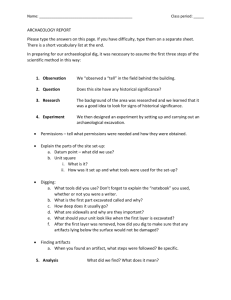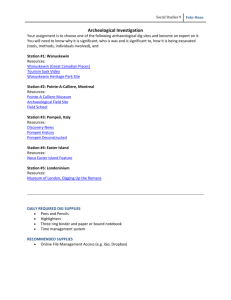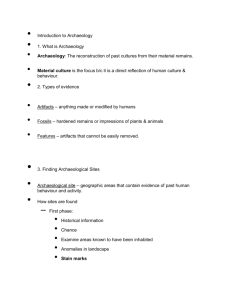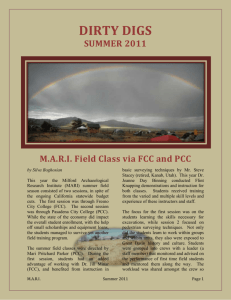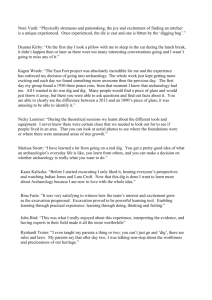Doing Archaeology in the Classroom
advertisement
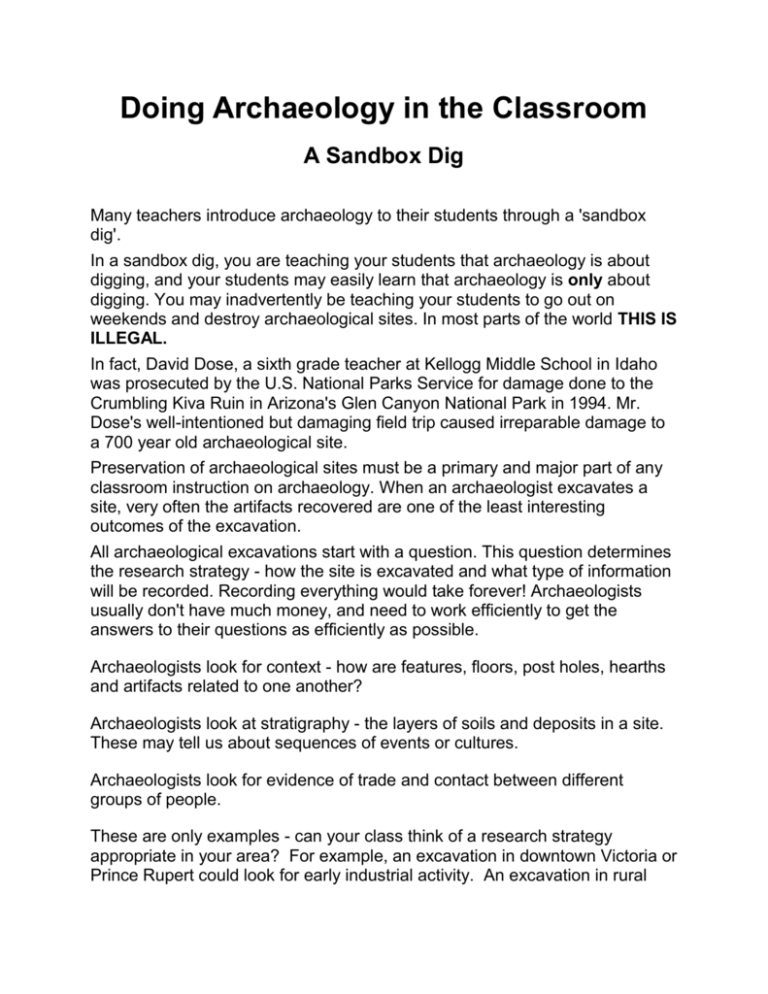
Doing Archaeology in the Classroom A Sandbox Dig Many teachers introduce archaeology to their students through a 'sandbox dig'. In a sandbox dig, you are teaching your students that archaeology is about digging, and your students may easily learn that archaeology is only about digging. You may inadvertently be teaching your students to go out on weekends and destroy archaeological sites. In most parts of the world THIS IS ILLEGAL. In fact, David Dose, a sixth grade teacher at Kellogg Middle School in Idaho was prosecuted by the U.S. National Parks Service for damage done to the Crumbling Kiva Ruin in Arizona's Glen Canyon National Park in 1994. Mr. Dose's well-intentioned but damaging field trip caused irreparable damage to a 700 year old archaeological site. Preservation of archaeological sites must be a primary and major part of any classroom instruction on archaeology. When an archaeologist excavates a site, very often the artifacts recovered are one of the least interesting outcomes of the excavation. All archaeological excavations start with a question. This question determines the research strategy - how the site is excavated and what type of information will be recorded. Recording everything would take forever! Archaeologists usually don't have much money, and need to work efficiently to get the answers to their questions as efficiently as possible. Archaeologists look for context - how are features, floors, post holes, hearths and artifacts related to one another? Archaeologists look at stratigraphy - the layers of soils and deposits in a site. These may tell us about sequences of events or cultures. Archaeologists look for evidence of trade and contact between different groups of people. These are only examples - can your class think of a research strategy appropriate in your area? For example, an excavation in downtown Victoria or Prince Rupert could look for early industrial activity. An excavation in rural Langley could look for evidence of Chinese merchants organizing horse and mule trains for the Cariboo wagon road. An excavation in the Kettle Valley could examine the living conditions of people who built the Kettle Valley railroad. Proposed activities: 1. Preserving archaeological sites A. Go on the internet and find your provincial or state laws about archaeological sites. What types of sites are protected? Do you need an archaeological permit from the government to dig? How would you get such a permit? If you see an archaeological site being disturbed or destroyed (for example, by road construction, by a housing development, by natural erosion) how do you contact the Archaeology Branch of your province or state? What fines or punishments are there for people who destroy archaeological sites? B. Go on the internet and find the conventions and recommendations the United Nations has about archaeology. The UN site is www.un.org C. Look up news reports from countries where archaeological sites have been damaged. (Hint: find web pages on archaeological sites and the Gulf War, on damage by war and deliberate looting in West Africa, Central America and Southeast Asia.) Class discussion: Why is it important to protect archaeological sites? D. Archaeological Context is important. Take two copies of a one page essay. Have a student cut out every word ending up with a pile of confetti with a word on each piece. Each piece of paper is like an artifact. By digging artifacts up, one is cutting them out from their context. Randomly take one handful away (another 'pothunter' took these artifacts years ago). Give several students a handful of words. Have the students try to reconstruct the essay. Reconstructing an archaeological site from a sub set of artifacts without context is similar. People who dig for artifacts without permission are destroying the meaning of the site - meaning that an archaeologist could figure out. 2. Survey A. Archaeological sites are not only places where First Nations lived before contact. An archaeological site could be practically anywhere. Some archaeologists specialize in recent archaeology, some do 'historic' archaeology, and some even do the archaeology of modern garbage (look at "Rubbish! : the archaeology of garbage' by William L. Rathje and Cullen Murphy, New York : Harper Collins Publishers, c1992). Do not do this with your class - you may be exposing them to health hazards in modern garbage. Get your class to observe a portion of your school yard over a period of several months. Every week at the same time, get the students to record the site as an archaeological survey. Remind them about safety rules about picking up dangerous things like needles, glass or condoms. How to survey an archaeological site: Designate a site datum in the school yard. A Datum is a mark that will NEVER move. It will become the point from which all measurements are taken. Choose a fixed point like the NE corner of the school building rather than a movable point like a piece of equipment. Mark the edges of the area to be observed. It will be easier if the area is square, oriented N/S/E/W and an exact number of meters (10, for example) Draw anything that will not move in the forseeable future (playground equipment, a fence, etc.) onto graph paper. Use a scale. Photocopy the form, with grid lines - these are your field record forms. Have students work in teams of four, one to record, one to measure distance from the datum, one to measure angle from the datum line, and one to record. The student teams will map and describe all artifacts found in the survey area each week. At the end, go over all the maps. (Photocopying each one onto an overhead transparency will allow you to see changes from week to week.) What kinds of artifacts were noted? What deductions can we make from these artifacts that will tell us something about the people who left them there? Are there any significant patterns to the groupings of artifacts (for example, are there any patterns which may tell you the age or sex of the children who frequent this part of the school yard?) Can we distinguish between cultural site formation processes (things people do that change the site) and natural site formation processes (natural things that change the site, like heavy rain, wind, erosion, even animal activity). Can we tell if there was a school yard cleanup day, or an activity like a sports day that may have changed the site (chalked lines, more garbage) If you had more than one group of students, were there differences in what they recorded? (sampling bias or sampling error?) If you did more than one area, are there detectable difference in the artifacts found? What can you deduce from these differences? B. Look near the school to find evidence of stratigraphy - visible layers in the soil. A good place to look is in banks where roads have been cut in, river or stream banks and open excavations in construction zones. Observe appropriate safety measures in these areas. Draw the stratigraphic profile of the cut you have found. Identify the layers. Which layers are oldest, newest? Can you think of a situation that would make the older layer on top? Can you find evidence of human activity in the profile - a post hole, a pit or a rock pile cairn? Can you find evidence of natural activity in the profile - a rodent burrow, a mud or rock slide? Why are some layers thicker than others? Olduvai Gorge is part of the Great Rift Valley of Africa. Natural erosion has exposed stratigraphic layers that were built up over millions of years. Mary and Louis Leakey surveyed this gorge for years, finding fossil hominids that tell us a great deal about early human evolution. Read an interview with Mary Leakey on the Scientific American web site: http://www.sciam.com/explorations/121696explorations.html C. Do a sandbox dig. 1. Formulate a research question. What do you want to find out by excavating this site? Some research questions could be: o 'What were the relationships between Chinese miners and EuroCanadian miners at Barkerville (where your sandbox dig is located, at least in your imagination!)?' o 'How did the people who were at this site interact with their neighbours (getting into issues of trade and economy)' o 'How did the people's culture change over time?' 2.Get permission. Get your students to draft a letter to the Archaeology Branch. This letter should outline your research question, describe your research strategy, ( e.g. excavation, screening with a .5 cm mesh screen, flotation of botanical remains, etc.), describe your record keeping methods, and designate a museum which agrees to take and preserve the results of your excavation. (Obviously, this is an exercise only!) 3. Assemble your tools. Trowels, buckets, tarps, small brushes, string (to mark off grid squares, excavation units), large nails (to hold the string) dental picks, tweezers, small plastic or paper bags, clipboards, recording forms, log books/site diary, pencils, tape measures, line levels, small screens, tin foil, jars to float seeds. 4. Use artifacts that will contribute to answering your research question. For example, if your research question was 'What kinds of food did people eat here?', be certain to use animal bones, vegetable remains, seeds, planting, or harvesting tools, food preparation tools and eating utensils. If the people who lived at your sandbox site were vegetarians, you may want to challenge your students by putting chicken bones in the dig. The students can look at the bones under a microscope and see if they have any butchering marks (cut marks made by a knife). If there are no butchering marks, maybe the chicken was a pet or kept only for eggs or feathers! Can the students distinguish between marks on bones made by a knife and marks on bones made by teeth? Get at least two different colours or types of matrix, e.g., grey sand and brown soil, fine clay, fine gravel. Add a lens of finely ground charcoal to indicate a fireplace in the middle of the lower layer. Put some lumps of charcoal with the finely ground charcoal. (The students can wrap them in tin foil without ever touching them with their hands - these are samples for radiocarbon or AMS dating.). Mix some seeds in the charcoal lens for the students to float. Put some fire blackened stones around the charcoal before you bury it. Make sure the lower layer is not flat on top- make the dig interesting by digging small pits. After you put the middle layer on, build a small structure by pushing sticks into the deposits, through the middle layer into the lower layer. Remove the structure (accelerated rotting!). See if the students find the post holes pushed into the lower stratum. It will be indicated by traces of the middle layer within the lower layer. This is easier to see if the lower layer is lighter in colour than the middle layer. Put modern artifacts in the top layer. Cover this all with a layer of humus or rotted compost. Cover the whole thing with sod or leaves and twigs. Hint: The deposits will compact better if you keep them wet. Spray them with a spritzer bottle as you build your layers. Let them settle if you can. A couple of days is good if you can keep cats out that long. Cover the sandbox with plastic to keep it damp. When you 'plant' your artifacts, pay attention to which ones you are placing close together. Group them within the matrix deposit type (i.e. up and down) as well as laterally. Try to group them in such a way that the students can draw intelligent deductions. Put most of them in the middle, but put some near the outside. Try to put the hole in the bottom layer where it will be half excavated and half left in the balk (side of the pit). Set up! Make a site datum. This is a mark that will NEVER move. It will become the point from which all measurements are taken. Get the students to mark off a square in the middle of the sandbox. Make it precisely square, boxed to the points of the compass. Use the 3-4-5 rule. Mark off the top of your excavation unit with nails and string. Make the string precisely level. Measure the distance in N and E meters or centimeters from your datum. Measure down from the datum and get an exact placement of the string in relation to the datum. Now make all measurements inside your excavation unit from the string. Be sure to mark the N/S/E/W sides of the unit. Excavate! Have the students work in threes. One is the designated recorder with a clip board, one measures, and one brushes or trowels. Draw the surface in plan view. Carefully brush or trowel the top layers. Every time you find a change of soil colour, texture or grain size, you must draw it. You have to decide if you are going to excavate in natural layers (following the changes in soil colour, texture or grain size, removing the top layer completely before you excavate any of the next) or excavate in arbitrary (10 cm layers that will cut across changes in soil colour, texture or, grain size) layers. Students will record each feature, each soil change and each artifact. Keep every artifact in a small paper bag with the exact 3 point location (North, East and level below datum) written on the bag. If you are digging in arbitrary levels you will also draw every 10 cm. As you dig, try to keep the walls straight and square. Do not lean or put any weight on the edge of the unit or it will collapse. If it gets dry it is more likely to collapse, keep spraying it. Cover it overnight. Profile! Draw each side of the pit on graph paper. Measure in all the soil changes. Catalogue! Describe and measure every artifact. Do not wash any artifacts you plan to test for residues (cutting tools, for example). Draw or photograph every artifact. Number every artifact. (Paint a small platform of nail polish, let it dry, ink on the number using a dip pen in india ink. Use black for light coloured artifacts, white for dark coloured artifacts.) Enter the catalogue on the computer master list. Subsequent analysis is the really important part of archaeology - What does this all mean? What can it tell us about the past? If you don't get to post-cataloguing analysis, you haven't done archaeology, you have just scientifically taken a site apart. Analyze! Try to figure out what the soil changes, the features and the artifacts are telling us. Some questions to ask your students: Can you identify any features in your unit? A feature might be a fire blackened area, a hearth ring of stones, a compacted or hardened area, a hole or a pit. Why would someone have dug a pit there? Link it to what was found in the pit. Can you make any deductions as to what these features may have been - a packed floor that was the floor of a house, an outside work area or a dance platform - a hole for a post, for a totem pole base, or a storage pit. Is there any faunal (animal bones or teeth) or floral (plant or seed) remains associated with these features that may help you make these deductions. When you make these deductions, what other deductions are you ruling out? Do you think it is a good idea to rule out some possible deductions early in your investigation? What artifacts did you find? Which ones were found together? Did they come from the same stratigraphic level? Can you tell which ones were earlier? Later? What can you tell about the activities the people did at your site? Did you find any intrusive artifacts (artifacts from somewhere else)? How could they have got into your site? Think of at least 4 different ways. What can this tell you about culture contact, trade and commerce? If you have time - excavate the rest of the sandbox, even if it is just with a shovel. Contrast the excavation unit you dug scientifically with the rest. The excavated unit was a sample, a sub set of the whole site. By only digging one part, what information, features, soil changes, artifacts etc. were missed? What percentage of the artifacts were found? Missed? How would your ideas of the site change if you had dug the entire box? Was your sampling strategy representative? If you actually do this entire dig - I would LOVE to hear about it! In fact, if you take pictures of your students doing each of these activities, send them to me and I will put them on the web in the next revision of this web site. Be certain to identify every student visible in each photograph. You MUST enclose signed forms from each child's parents allowing their child's picture to be placed on the SFU web site. I reserve the right to select and edit images. Email me at bwinter@sfu.ca
